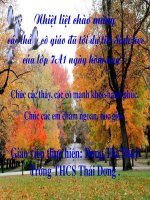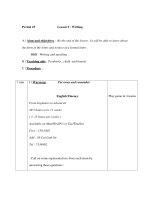Tải Giáo án Tiếng Anh lớp 10 Unit 4: Special education - Lesson 5 - Giáo án điện tử môn Tiếng Anh lớp 10
Bạn đang xem bản rút gọn của tài liệu. Xem và tải ngay bản đầy đủ của tài liệu tại đây (97.87 KB, 2 trang )
<span class='text_page_counter'>(1)</span><div class='page_container' data-page=1>
<b>UNIT 4: SPECIAL EDUCATION</b>
LESSON 5. LANGUAGE FOCUS
<b>I. Objectives:</b>
<b>1. Education Aims:</b>
- The sound /a/ from the sound / ɔ:/ and pronounce them correctly.
<i>- " the + adjective" as a noun, review "used to + infinitive" and combine "which".</i>
<b>2. Knowledge:+ Language: </b>
- Pronunciation: /a/ and / ɔ:/
<i>- The + adjective.</i>
<i> - Used to + infinitive. </i>
<i>- Which as a connector.</i>
<b>3. Skills:</b> + Speaking: Work in pairs to discuss the exercises.
+ Reading: - Read words and sentences aloud.
- Read the sentences silently to do the exercises.
<b>II. Anticipated problems: pronounce sound /a/ correctly.</b>
<b>III. Teaching aids: board, chalk, textbook.</b>
<b>IV. Procedures: </b>
<b> Teacher's activities</b> <b> Students' activities</b>
<b>1. Homework checking: (5mins)</b>
- Ask one st to do the homework on the board
- Ask one st to give remarks.
- check and give a mark.
<b>2. Pronunciation: (10 mins)</b>
<i>- Aims: to introduce two sound /a/ and / ɔ:/ and help sts to </i>
<i>practise these sounds.</i>
<b>a. Write two sounds on the board and pronounce them clearly </b>
twice, then ask sts to repeat.
- Tell sts the difference between two sounds.
- Ask them to look at the textbook, listen and repeat.
- Then ask sts to work in pairs to read the words again so that
they can check for each other.
- Move around to help .
- Ask two sts to read again and give remarks.
<b>b. Ask sts to look at sentences in page 52 in the book.</b>
- Ask them to work in pairs to read the sentences and then find
out the words containing sound /a/ and the words containing
sound / ɔ:/.
- Ask some sts to read these sentences aloud.
- Listen and give remarks.
<b>3. Grammar: (29 mins)</b>
<i><b> a. Aims: to introduce " the + adjective"as a noun and have sts </b></i>
<i>do Ex 1.</i>
<i>- Present the use of " the + adjective" by giving examples.</i>
<i>E.g: The young are very active.</i>
<i> Her real joy is looking after the old.</i>
- Focus sts on the underlined words and ask them to try to guess
their meaning.
<i>- Give the answer: "we use " the + adjective "to describe a group </i>
<i>of people."</i>
- Listen to the teacher and repeat.
- Look at the book, listen and
repeat.
<i> top call </i>
<i> boss sport</i>
<i> doctor four</i>
...
- Read these words in pairs and
check for their partners.
- Look at the book and work in
pairs.
- Answers:
/a/ / ɔ:/
<i> socks lost</i>
<i> on doctor</i>
<i> top walking</i>
<i> box called</i>
<i> job sport</i>
<i> ...</i>
- Read the examples.
- Try to guess the meaning
<i>S: - The young = young people</i>
<i> - The old = old people.</i>
- Copy these words.
- Listen and repeat.
- Some sts read again.
<i>EX 1:</i>
<i>1. the injured</i>
<i>2. the unemployed</i>
<i>3. the sick</i>
</div>
<span class='text_page_counter'>(2)</span><div class='page_container' data-page=2>
- Ask sts to look at Ex1 and to do the task.
<i>- Explain any new words if necessary+ 'ambulance (n) : a kind </i>
of vehicles used to carry sick/injured people.
<i>+ unemp'loyed (n) : without a paid job.</i>
- Read these words aloud and ask sts to listen and read these
words again.
- Listen and give remarks.
<i><b>b. Aims: to review " used to + infinitive" and get sts to do Ex 2.</b></i>
<i><b>- Ask sts to recall the use of "</b><b> used to"</b><b> by giving an example:</b></i>
<i>" She used to get bad marks when she was at primary school"</i>
- Ask sts to do Ex 2 individually and then share the answers
with their friends.
- Check and give remarks.
<i><b>c. Aims: to revise the use of " which" as a connector and ask sts </b></i>
<i>to do exercise 3.</i>
- Recall sts of the relative clauses with "which" used to refer to
the whole of the earlier clause.
- Ask sts to read the requirement of Ex2 and read the example
carefully.
- Ask some sts to read sentence by sentence.
- Listen and give remarks.
<b>5. Homework (1 min)</b>
- Part B (Page 24- workbook)
- Think about the teacher's
question and answer:
<i>- S: We use " used to + infinitive" to </i>
<i>talk about past actions or past </i>
<i>habits that no longer exist.</i>
- Do the exercise individually and
compare their answers with their
partners.
- Do the exercise on the board.
<i>2. used to have 3. used to live</i>
<i>4. used to eat 5. used to be</i>
<i>6. used to take 7. used to be</i>
<i>8. did you use to go</i>
- Listen to the teacher.
- Read the requirement and the
example carefully.
- Do Ex 3.
</div>
<!--links-->









